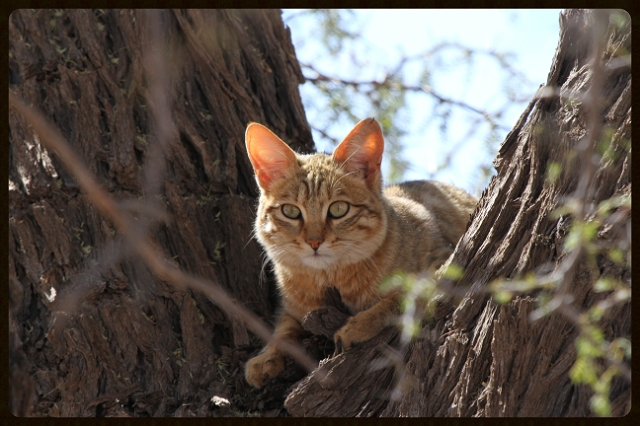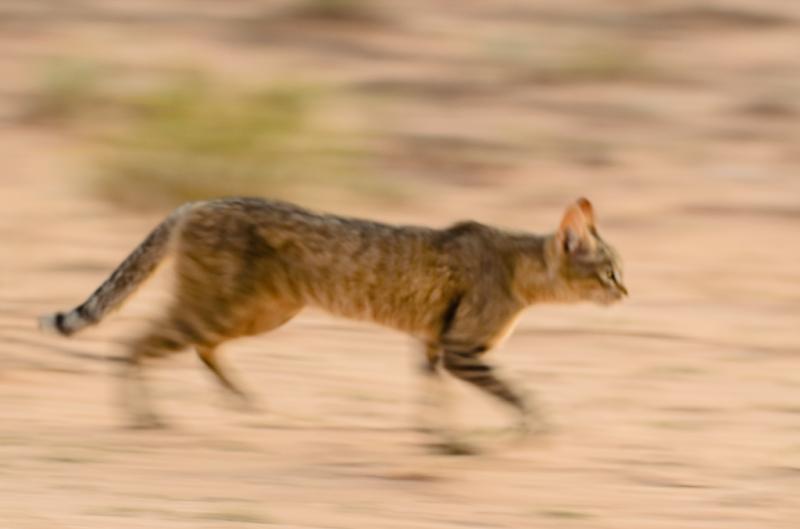Kingdom: Animalia
Phylum: Chordata
Class: Mammalia
Order: Carnivora
Family: Felidae
Genus: Felis
Species: F. silvestris
Subspecies: F. s. lybica
The African wildcat (Felis silvestris lybica) is a wildcat subspecies that occurs across Africa and extends around the periphery of the Arabian Peninsula to the Caspian Sea. As it is the most common and widely distributed wild cat, it is listed as Least Concern by IUCN since 2002.
The African wildcat appears to have diverged from the other subspecies about 131,000 years ago. Some individual African wildcats were first domesticated about 10,000 years ago in the Middle East, and are the ancestors of the domestic cat. Remains of domesticated cats were found in human burials in Cyprus that are estimated to have been established by Neolithic farmers about 9,500 years ago. Crossings between domestic cats and African wildcats are still common today.
Characteristics
The fur colour of the African wildcat is light sandy grey, and sometimes with a pale yellow or reddish hue. The ears are reddish to grey, with long light yellow hairs around the pinna. Stripes around the face are dark ochre to black: two are running horizontally on the cheek, and four to six across the throat. A dark stripe is running along the back, the flanks are lighter, and the belly is whitish. Pale vertical stripes on the sides often dissolve into spots. Two dark rings are on the forelegs, and hind legs are striped. The feet are dark brown to black.
Pocock described the African wildcat as differing from the European wildcat by inconspicuous stripes on the nape and shoulders, a less sharply defined stripe on the spinal area and by the slender tail, which is cylindrical, less bushy and more tapering. Ears are normally tipped with a small tuft.
Skins of male wildcats from Northern Africa measured 47–59.7 cm (18.5–23.5 in) in head-to-body length with a 26.7–36.8 cm (10.5–14.5 in) long tail. Skins of female wildcats measured 40.6–55.8 cm (16.0–22.0 in) with a 24.1–33.7 cm (9.5–13.3 in) long tail.[7] Male wildcats from Yemen measured 46–57 cm (18–22 in) in head-to-body length with a 25–32 cm (9.8–12.6 in) long tail; females were slightly smaller measuring 50–51 cm (20–20 in) in head-to-body length with a 25–28 cm (9.8–11.0 in) long tail. Both females and males ranged in weight from 3.2 to 4.5 kg (7.1 to 9.9 lb).
Distribution and habitat
African wildcats occur across Africa and around the periphery of the Arabian Peninsula to the Caspian Sea. They are found from Morocco through Algeria, Tunisia, Libya and into Egypt, and inhabit the savannas of West Africa from Mauritania to the Horn of Africa, including Somalia, Eritrea, Ethiopia, Djibouti and Sudan, southwards to South Africa. They inhabit a broad variety of habitats, especially in hilly and mountainous landscapes such as the Hoggar. But in deserts such as the Sahara they occur at much lower densities. Much better adapted to desert habitats are sand cats.
Ecology and behaviour
The African wildcat eats primarily mice, rats and other small mammals. When the opportunity arises, it also eats fish, birds, reptiles, amphibians, and insects. The cat approaches its prey slowly, and attacks by pouncing on its prey as soon as it is within range (about one metre). The African wildcat is mainly active during the night and twilight. When confronted, the African wildcat raises its hair to make itself seem larger in order to intimidate its opponent. In the daytime it usually hides in the bushes, although it is sometimes active on dark, cloudy days.
A female gives birth to two to six kittens, with three being average. The African wildcat often rests and gives birth in burrows or hollows in the ground. The gestation lasts between 56 and 69 days. The kittens are born blind and need the full care of the mother. Most kittens are born in the wet season, when there is sufficient food. They stay with their mother for five to six months and are fertile after six months.
from Wikipedia

near Dalkeith




